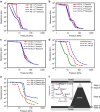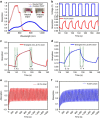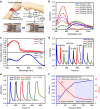A chameleon-inspired stretchable electronic skin with interactive colour changing controlled by tactile sensing
- PMID: 26300307
- PMCID: PMC4560774
- DOI: 10.1038/ncomms9011
A chameleon-inspired stretchable electronic skin with interactive colour changing controlled by tactile sensing
Abstract
Some animals, such as the chameleon and cephalopod, have the remarkable capability to change their skin colour. This unique characteristic has long inspired scientists to develop materials and devices to mimic such a function. However, it requires the complex integration of stretchability, colour-changing and tactile sensing. Here we show an all-solution processed chameleon-inspired stretchable electronic skin (e-skin), in which the e-skin colour can easily be controlled through varying the applied pressure along with the applied pressure duration. As such, the e-skin's colour change can also be in turn utilized to distinguish the pressure applied. The integration of the stretchable, highly tunable resistive pressure sensor and the fully stretchable organic electrochromic device enables the demonstration of a stretchable electrochromically active e-skin with tactile-sensing control. This system will have wide range applications such as interactive wearable devices, artificial prosthetics and smart robots.
Figures







References
-
- Hammock M. L., Chortos A., Tee B. C.-K., Tok J. B.-H. & Bao Z. 25th anniversary article: the evolution of electronic skin (e-skin): a brief history, design considerations, and recent progress. Adv. Mater. 25, 5997–6038 (2013). - PubMed
-
- Dahiya R. S., Metta G., Valle M. & Sandini G. Tactile sensing—from humans to humanoids. IEEE Trans. Robotics 26, 1–20 (2010).
-
- Dahiya R. S., Mittendorfer P., Valle M., Cheng G. & Lumelsky V. Directions towards effective utilization of tactile skin—a review. IEEE Sensors J. 13, 4121–4138 (2013).
-
- Kim D. H. et al. Epidermal electronics. Science 333, 838–843 (2011). - PubMed
-
- Takei K. et al. Nanowire active-matrix circuitry for low-voltage macroscale artificial skin. Nat. Mater. 9, 821–826 (2010). - PubMed
Publication types
MeSH terms
LinkOut - more resources
Full Text Sources
Other Literature Sources
Research Materials

